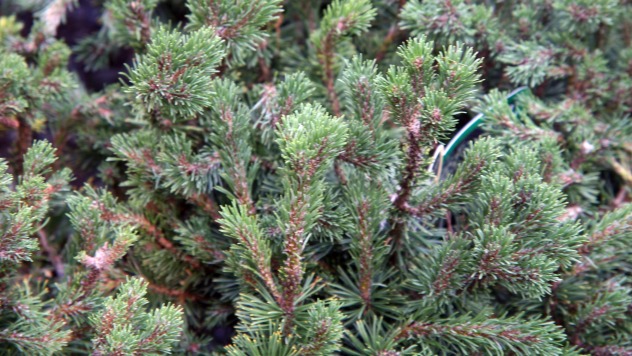A Mugo’s natural form should be balanced against the size you will allow it to grow.
(Photo credit: “Pinus mugo 0zz" by David J. Stang, licensed under CC BY-SA 4.0.)
(Continued from Mugo Pines 1)
A series of tight bud scars is most often seen in new plantings and indicates a tree that was dug incorrectly, leaving too much root mass in the ground and then planted too deep. The third fatal blow would be water stress. This tree is unhappy, and its minimal growth for a period of years will attest to it. Hence, the tight group of bud scars.
Back to Mugos themselves.
When you have clearly seen how a pine is going to grow each year, it will give you what you need for choosing the right planting site. For the tight growing, dense look, choose a Mugo that grows one to two inches per year. If you want a larger plant approaching tree form, choose one that grows a foot or more per year. There are plenty of the taller growing varieties around town that were never pruned and are now truly trees. Most people wouldn't think they are Mugos because of their great size. One that I saw last fall near North Hill Mall was two-stemmed and approximately 50 feet tall.
The critical idea from this discussion about size and growth patterns is that a Mugo’s natural form should be balanced against the size you will allow it to grow. For example, I have seen many fast-growing Mugos in group plantings with their spindly, wispy growth, too tall, with lots of open spaces, held back by pruning that just doesn’t look right.
If you had a planting plan for a variety bed at the front of your house and that plan included a tight conpacta Mugo, but a fast-growing, spindly Mugo was planted by mistake, no amount of pruning will give you the look you want. What happens is that the Mugo gets chopped to fit into the space that was allowed for it and looks pruned, pruned, pruned.
I personally don’t like plants to look pruned. I believe that, if pruned with some finesse, some style, most of the pruning can be easily hidden and the pruned plant looks completely natural. This is one major aspect of an arborist’s art: pruning so that it doesn’t look pruned. I know a lot of this discussion has turned to aesthetics, but I do believe that most of us would quickly agree on what is pleasing and what is blaring. Most of us are looking for a graceful, natural look, where the sight lines and forms flow well together. A chopped plant in the middle of that sticks out like a sore thumb.
(Continued in Mugo Pines 3: Pruning)
(Photo credit: “Pinus mugo 0zz" by David J. Stang, licensed under CC BY-SA 4.0.)









